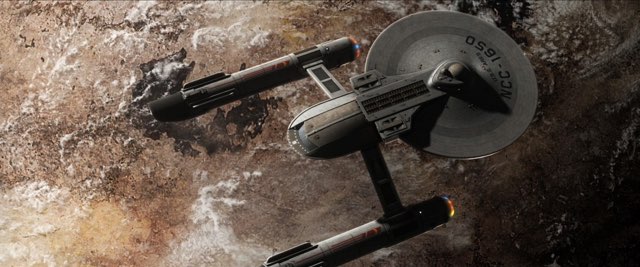Examining the Case Law Behind the Motion to Dismiss
Table of Contents
UPDATE The defense filed a new Motion to Dismiss on March 28. It featured a few new arguments but largely repeats the assertions in the first motion, so many of the points made here still hold.
The defendants’ Motion to Dismiss the copyright infringement lawsuit brought against Alec Peters and Axanar Productions cites many legal precedents to bolster its case for dismissal. But what does an examination of that case law actually demonstrate?
In a post on the blog for the popular Star Trek podcast, “The G&T Show,” attorney Janet Gershen-Siegel looks at the cases cited by Axanar attorney Erin Ranahan.
Five Reasons to Dismiss
Here are the five essential arguments the defense offers to convince federal Judge R. Gary Klausner to dismiss the studios’ legal complaint, or at least strike out parts of it. The defense contends the plaintiffs failed to:

- Specify the copyrights being infringed, thereby failing to properly notify the defendants.
- Identify who, between CBS and Paramount, owns which copyright.
- Base their allegations on anything more than “information and belief,” a standard the defense believes is insufficient for a valid legal complaint.
- Show how they can claim infringement by a film that has not yet been produced.
- Justify an injunction halting production because it would be a prior restraint on free speech.
Vague Copyright Claims
The defense calls for dismissal because CBS and Paramount don’t specify exactly which of their copyrights were infringed, citing four cases to back them up. Of them, Siegel says only one directly applies.
Chestang v. Yahoo is a case brought on unclear pleadings. In that matter, however, Siegel says, the court allowed an amended pleading, rather than dismissing; the other cited cases are procedural technicalities, easily dealt with in an amended complaint. “A ‘win’ in this area for the defense is hardly a win at all,” she writes.1)
Who Owns What?
The motion asserts that the ownership of Star Trek has changed hands so many times it’s unclear who owns which copyrights Axanar is supposed to have infringed upon.
For this, the motion cites Bell Atl. Corp. v. Twombly, a 2007 case in which the breakup of regional phone companies created confusion over which division was responsible for what. Apart from the fact all Star Trek copyrights are held between the two plaintiffs, Siegel argues that the strict corporate regulations in the Sarbanes-Oxley law are more likely than not to have required CBS and Paramount to have documentation showing how Star Trek rights are divvied up by the two studios:
To my mind, this appears to be the weakest of the first three defense statements. After all, you can find the copyright holders yourself by checking the Library of Congress’s copyright listings.2)
'Information and Belief'
The defense quotes case law it says requires more facts than the legal complaint offers in its allegations based “on information and belief” — essentially, secondhand knowledge rather than actual facts.
Here, the motion relies on two cases, the Twombly case noted above and Ashcroft v. Iqbal (2009), which raised the standard on assertions made in legal pleadings based “on information and belief.” Those cases, however, require pleadings to make allegations that are not simply conceivable, but also plausible.3) The defense needs to show the plaintiffs’ allegations are so complex and difficult that more detailed allegations need to be submitted.
Under this view, a key task for a defendant, in addition to marshaling complaint-specific arguments … will be to emphasize every facet of the case that would warrant a more stringent application of the plausibility standard.4)
Does Axanar’s motion to dismiss do this? Attorney Siegel believes any deficiency is easily addressed in an amended complaint.5)
Too Soon to Sue
The defense believes that any claims related specifically to the as-yet-unproduced Axanar film should be dismissed, saying the court can’t determine whether a film infringed or not if it hasn’t been made yet.
Siegel examines the five cases cited to support this argument, concluding:
- Only one resulted in a dismissal but without prejudice, meaning it could be re-filed.
- Another dealt with a patent on the design of a concrete, tangible item as opposed to works of fiction that are “often edited and otherwise amended even after they are considered completed, and without said editing converting them back to incomplete status.”
- Two cases dealing with works that couldn’t demonstrably be shown to copy an original work, which doesn’t really comport with Axanar‘s outright identification with Star Trek.6)
Censorship
The defense argues the injunction sought by CBS and Paramount would be {!prior restraint:censorship, imposed on expression before the expression takes place}} — censorship before Axanar has even been produced, a violation of First Amendment rights.
To back up this claim, attorney Ranahan cites the famous Pentagon Papers case (New York Times v. United States). “I am having trouble seeing where it relates to this matter,” Siegel says,7) finding a fundamental difference between publication of documents in which the public has a compelling interest in the activities of their government, and the “creation of a work of fictional media”8) based on copyrights that have their own protection under the U.S. Constitution.9)
More Thorough Analysis
Siegel is posting a second blog focusing on a more thorough examination of the motion to dismiss.10)
Keywords


